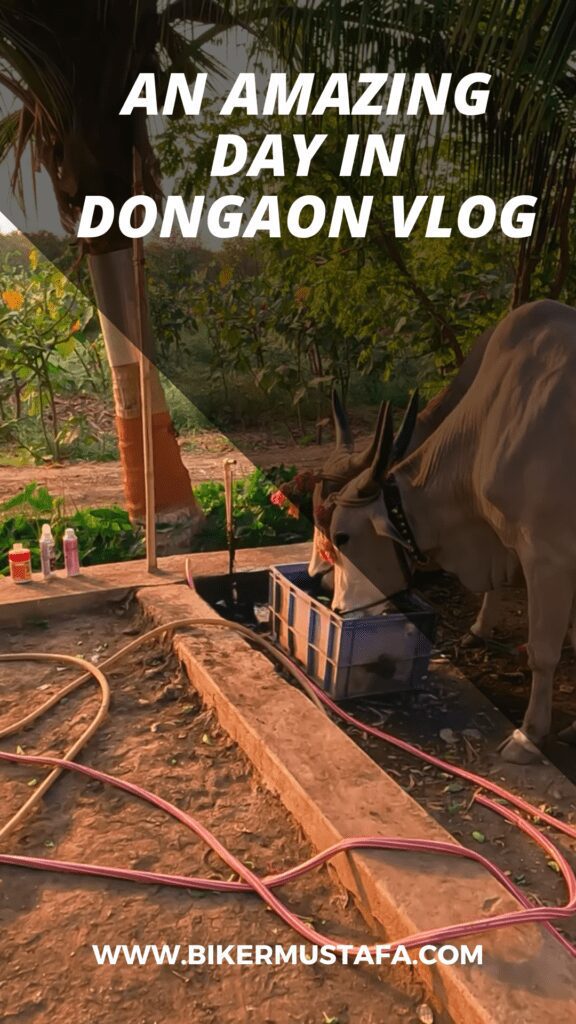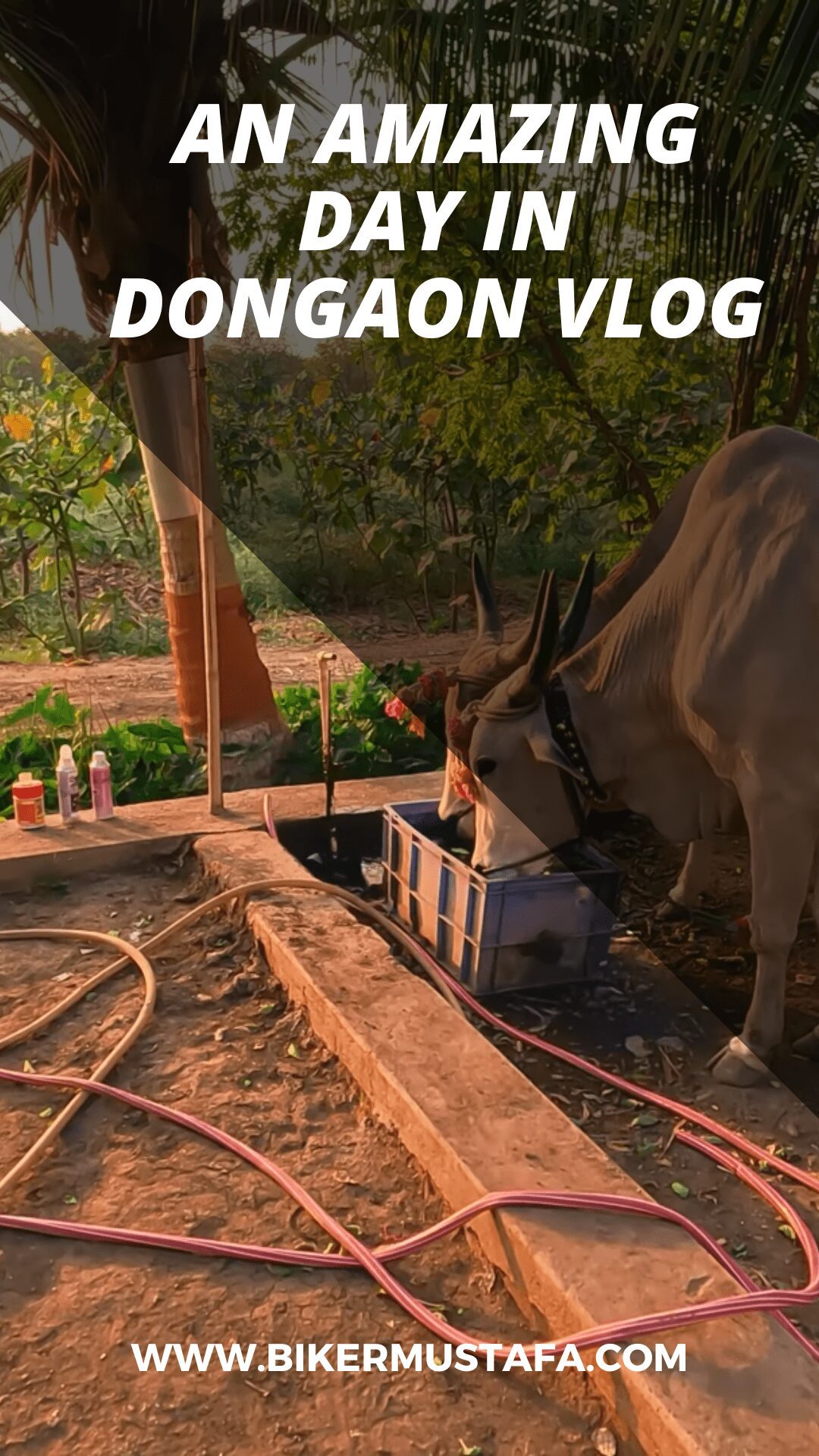
An Amazing Day in Dongaon : Vlog – Solo Ride on Dominar 400 [S1 – Ep 1]
Regarding Dongaon
The location code or village code for Dongaon village is 529029, according to Census 2011 data. In the Buldana district of Maharashtra, India, Mehkar Tehsil is home to the village of Dongaon. It is located 80 kilometers from Buldana, the district headquarters, and 17 km from Mehkar, the sub-district headquarters, and tehsildar office. According to data from 2009, Dongaon village also has a gram panchayat.
The village has a total size of 3753 hectares. 18,012 people are living in Dongaon, with 9,323 of them being male and 8,689 being female. Dongaon village has a literacy rate of 72.42%, with 77.63% of men and 66.84% of women being literate. In the village of Dongaon, there are roughly 3,762 homes. Dongaon Village’s pin code is 443303. The closest town to Dongaon for all main economic activities is Mehkar, which is located about 17 kilometers away.
| TEHASIL | MEHKAR |
| DISTRICT | BULDANA |
| STATE | MAHARASHTRA |
| COUNTRY | INDIA |
DONGAON’S NEAREST BEST PLACES TO VISIT
Noorudin Saheb’s Mazaar-E-Maulai
At Dongaon Tq. Ambad is where Moulai Nuruddin’s mausoleum, Mazaar-E-Maulai, is located. Moulai Nuruddin was chosen by the D”, the center of Yemen, to lead the dawat in India as a “Wal al-Hind” (representative/caretaker for India). To learn, Moulai Nuruddin traveled to Cairo, Egypt. He then traveled to India’s Deccan region in 467 A.H. On Jumadi al-Ula 11, he passed away in Dongaon Tq. Ambad, Dist.Jalna.
Lake Loner
Lonar Lake, often referred to as Lonar Crater, is a salty, soda lake designated as a National Geo-heritage Monument in the Buldhana district of Maharashtra, India. During the Pleistocene Epoch, a meteorite hit produced the asteroid known as Lonar Lake. There are just four hyper-velocity impact craters in the basaltic rock known to exist anywhere on Earth. Southern Brazil is home to the other three basaltic impact formations. Lonar Lake is about 137 meters (449 feet) below the crater rim and has a mean diameter of 1.2 kilometers (3,900 feet). The meteor crater’s edge has a diameter of roughly 1.8 kilometers (5,900 feet).
The Deccan Plateau, a vast plain of volcanic basalt rock formed by eruptions around 65 million years ago, contains Lonar Crater. Some geologists hypothesized it was a volcanic crater based on its placement in this basalt field. However, it is now known that a meteorite impact created Lonar Crater. Both saline and alkaline water can be found in the lake.

Numerous research on various facets of this crater lake’s ecosystem has been published by geologists, ecologists, archaeologists, naturalists, and astronomers.
Older studies put the crater’s age at 52,000–6,000 years, but more recent research puts it at 576,000–47,000 years. The Smithsonian Institution has extensively studied the site, the United States Geological Survey, the Geological Survey of India, the University of Sagar, and the Physical Research Laboratory.
In this lake, biological nitrogen-fixing was found in 2007. According to a 2019 study by IIT Bombay, the minerals in lake soil are highly similar to those identified in moon rocks returned by the Apollo Program. In November 2020, the lake was designated as a protected Ramsar site.
History
Ancient texts like the Skanda Purana and the Padma Purana are the first to reference the lake. According to the Ain-i-Akbari, which was composed in 1600 CE, These mountains produce all the materials needed to create soap and glass. Additionally, these saltpeter operations generate substantial tax money for the government. There is a saltwater spring on these mountains, yet the water from the center and the margins is fresh.
The lake’s location in Maharashtra’s Buldhana district was formerly a part of the Mauryan Empire and, afterward, the Satavahana Empire. The Rashtrakutas and Chalukyas also governed this region. Trade flourished in this region under the rule of the Mughals, Yadavas, Nizam, and British empires. On the lake’s edge are several temples known as Yadava and Hemadpanti temples (named after Hemadri Ramgaya).
The Maharashtra state government started preparing to develop the location as a tourism destination in 2022.
Lake Ambar
Around 700 meters (2,300 feet) from the main lake, a slight circular depression is thought to have been created by a piece of the significant meteor. A Hanuman temple with a granite idol thought to be highly magnetic is located close to this lake. Local farmers are draining the water from Ambar Lake. Other names for this lake include Chhota (small) Lonar.
Geographic Characteristics
The crater is seen from the edge. Underneath, in the forest, is a shrine. The basin is surrounded by several minor hills and has an almost circular, oval-shaped shape with an 8-kilometer top circumference (five miles). The basin’s walls climb sharply at an angle of around 75 degrees. The lake is 4.8 kilometers around at the base of the sides (three miles). The slopes are covered in shrub- and tree-savannah, which is home to Acacia nilotica and Ziziphus spp. as well as teak (Tectona grandis), Wrightia tinctoria, Butea monosperma, and Helicteres isora. Prosopis juliflora, a non-native plant, is spreading along the lakeshore. The principal crops grown are millet, maize, okra, bananas, and papaya.

Different types of salts and sodas are present in the lake’s water. When evaporation lowers the water level, large amounts of soda are gathered in dry weather. The lake is fed by the Purna and Penganga tiny streams, and on its southern edge, near the water, is a freshwater well.
Geologically Based
- Crater of Lonar
- Asia is where Lonar Crater is located.
- The Lonar crater.
- Asia-based asteroid crash site.
- Impact crater or building.
- Diameter- 1.8 km (1.1 mi)
- Depth- 290 m (950 ft)
- Age- 570 ± 47 Ka
- Country- India
Lake in the Lonar crater as seen from space.
The sole alien impact crater within India’s enormous basaltic deposit known as the Great Deccan Traps is where Lonar Lake is located. Initially thought to be volcanic, the lake is now understood to be an impact crater. A comet or an asteroid collision led to the formation of Lonar Lake. The impact origin of this crater has been established by the presence of plagioclase that has either undergone the transformation into maskelynite or has planar deformation characteristics. Plagioclase is thought to only experience shock metamorphism following a hypervelocity collision, producing planar deformation characteristics. The impact origin of Lonar Lake is supported by the impact deformation of the basalt layers that make up the crater rim, the shocked breccia inside the crater, the shatter cones present, and the non-volcanic ejecta blanket encircling the crater.
The crater is shaped like an oval. The meteorite struck at an angle of 35 to 40 degrees from the east.
The crater’s age is guessed in several different ways. The crater may be far older than previously thought; new argon-argon dating reveals that it may be 570 000–47 000 years old. Earlier thermoluminescence investigations yielded a value of 52,000 years. The crater rim’s level of erosion is consistent with its old age.
According to the findings, the geological features of the Lonar crater can be split into five distinct zones that each have unique geomorphic traits. There are five zones:
- Ejecta’s outermost blanket.
- The Rim of the crater.
- The crater’s incline.
- Excluding the lake, the crater basin.
- Lake in a crater.
The lake’s by Products
The Gazetteer documents the discoveries of British administrators and scientists, including Colonel Mackenzie, scientist Dr. I. B. Lyon, J.O.Malcolmson, and agricultural chemist Plymen. Some excerpts from Plymen’s report, given in quotes, are helpful.
The saline deposits obtained from the lake are of exceptional quality. It can be seen that compared to the most famous salt lake in India, the Sambhar Lake in Rajasthan (India). In contrast, the carbonates of soda are the most important at Lonar. Deposits of sodium chloride or common salt give the lake its value. The modes of formation are also entirely different, and it is almost certain that the Lonar salts come from an unknown source in the lake bed. It is true that water is constantly flowing into the lake and that there is no loss other than evaporation. The main feeder stream, however, could not supply this amount of alkali, nor could the other smaller supplies coming in during the rains because the vegetation is abundant on all sides of the lake, mainly where the main stream flows in continuously. If any amount of alkali were present in this water, vegetation would suffer greatly and, except for a few plant varieties, would eventually die out.

The salts collected from this lake vary in nature and composition, and men familiar with them can easily separate them based on their appearance. There are several names for the five or six main varieties, but there is no clear distinction between them. Their compositions depend on the period and condition of crystallization. Large quantities of these salts are currently found on the lake’s shores.
Sodium chloride or common salt is formed along with soda carbonates during the crystallization process, resulting in several products, as explained below.
White crystalline masses of Kala Namak and Nimak Dalla can be found. Khuppal is obtained in solid compact lumps and comprises a roughly equal mixture of carbonates and chlorides. Pipadi or Papri, which have a similar chemical composition, look very different. It is frequently tinged and slightly pink, and there are hollow air spaces between the crystalline masses that form in flakes or layers. Bhuski has no distinct structure and is composed of a soft, flaky powder mixed with a small amount of impurity. It is comparable to a small amount of salt or baking soda. All salts are not obtained in the same way or at the same time of year. Pipadi and Bhuski are deposited on the lake’s shores as the water evaporates in the hot weather, with Pipadi being the upper layer and thus purer. Except for Bhuski, the salts are relatively pristine and contain only trace amounts of earthy matter. Their further purification is not thought to be complicated.
Commercial exploitation of lake salts dates back to 1842, including the reign of Nizam, and continued until 1903. Currently, there is very little local demand for these Lonar Lake products.
Gaylussite is a mineral.
Gaylussite is a mineral recently discovered in the drill core from Lonar Lake. Gaylussite is a hydrated sodium calcium carbonate with the formula Na2Ca(CO3)2H2O. Translucent, vitreous white to grey to yellow monoclinic prismatic crystals are found. It is an unstable mineral dehydrates and decomposes in water when exposed to dry air. Streptomyces alkalithermotolerans is an alkaliphilic and thermotolerant Streptomyces bacterium species isolated from the Lonar soda lake in India.

The lake ecosystem
The lake’s chemical properties show two distinct regions that do not mix – an outer neutral (pH 7) and an inner alkaline (pH 11), each with its flora and fauna. The lake is home to a diverse array of plant and animal life.
160 birds, 46 reptiles, and 12 mammal species are on the property. The lake is home to a variety of resident and migratory birds, including black-winged stilts, brahmin ducks, grebes, shelducks (European migrants), shovellers, teals, herons, red-wattled lapwings, rollers or blue jays, baya weavers, parakeets, hoopoes, larks, tailorbirds, magpies, robins,
The monitor lizard is said to be a prominent reptile. Thousands of peafowl, chinkara, and gazelles live in the lake. On November 20, 2015, the government designated 3.83 km2 (1.48 sq mi) as the Lonar Wildlife Sanctuary.
Microbiological Diversity
While Lonar Lake appears green for most of the year due to dense blooms of cyanobacteria such as Arthrospira spp., bacteria and archaea from various functional groups such as methanogens, methanotrophs, phototrophs, denitrifiers, sulphur oxidizers, sulfate reducers, heterotrophs, and syntrophs have been found.
In molecular surveys of Lonar Lake sediments, numerous alveolates, fungi, stramenopiles, choanoflagellates, amoebozoans, and cercozoans, as many novel lineages of putative micro-eukaryotes, were discovered. From lake sediment microcosms containing enriched populations of methylotrophic bacteria, gene sequences of ciliated protozoans like Oxytricha longa and fungi like Candida spp. were also recovered. Curvularia lonarensis, a new species of fungus found in the lake, has been described.
Microorganisms with notable functional groups:
Methylotrophic Microorganisms
- Methylotrophs from Methylomicrobium, Methylophaga, and Bacillus species have been found in the sediments of Lonar Lake.
- Methane-oxidizing methylotrophs (methanotrophs) were also found in the lake water column’s surface scum.
- Methylophaga lonarensis, a novel non-methane-utilizing methylotroph, was isolated in pure culture from lake sediment microcosms.
- This haloalkaliphilic bacterium synthesizes and intracellularly accumulates organic solutes of biotechnological interest, such as ectoine.
- The primary microorganism (archaeon) responsible for methylotrophic methanogenesis in Lonar Lake sediments has been identified as closely related to Methanolobus oregonensis.
Microorganisms found in Endoliths
Endolithic bacteria from the phyla Actinobacteria, Acidobacteria, Proteobacteria, Firmicutes, Cyanobacteria, Bacteroidetes, and endolithic archaea from the phyla Thaumarchaeota and Euryarchaeota, were found in Lonar basalt rock samples taken from the crater walls and lake bed. Endolithic bacteria were found to have greater diversity and richness than endolithic archaea in these samples. Most endolithic prokaryotes were putative methanotrophs, methanogens, phototrophs, ammonia-oxidizers, nitrogen-fixers, denitrifiers, dissimilatory sulfate-reducers, and metal-reducers.
Microorganisms That Fix Nitrogen
Nonsymbiotic nitrogen-fixing microorganisms found in this lake include Halomonas sp., Paracoccus sp., Klebsiella sp., Slackia sp., and Actinopolyspora sp. Because they can only grow at pH-11, all nitrogen fixers are haloalkaliphilic. Some bacteria and actinomycetes isolated from this lake can grow on an inorganic medium containing martian soil simulant components.
The color shift in 2020
During June 2020, the water in Lonar Crater Lake will turn pink. The lake turned red/pink in 2-3 days in early June 2020. According to reports from the Agharkar Research Institute, the National Environmental Engineering Research Institute, and the Geological Survey of India, low water levels and high salinity stimulated the growth of Halobacterium and increased Carotenoid levels, resulting in color change.
Religious context
The lake is surrounded by numerous temples, the majority of which are in ruins today, except for the temple of Daitya Sudan in the center of Lonar town, which was built to commemorate Vishnu’s victory over the giant Lonasur. It’s an excellent example of early Hindu architecture. Other temples inside the crater include Vishnumandir, Wagh Mahadev, Mora Mahadev, Munglyacha Mandir, and Goddess Kamalaja Devia.
Temple of Daitya Sudan
The Daitya Sudan temple from the side
The Daitya Sudan Temple is a Vishnu temple from the Chalukya Dynasty, which ruled Central and Southern India from the sixth to the twelfth centuries. It is of the Hemadpanthi type and is built in an irregular star shape. It has carvings that are similar to those found in Khajuraho temples. This temple’s deity is made of ore with a high metal content that looks like stone. Carvings can be found on the temple’s ceiling. Carved figures adorn the exterior walls as well. The temple’s plinth is about 1.5 m (4.9 ft) high, and the unfinished roof suggests a pyramidal form for the tower.
The best example of the Hemadpanthi style is the temple of Daitya Sudan in Lonar. The standing image of Surya in the central niche on the temple’s back suggests that the temple was initially dedicated to the Sun god. However, its current form is a Vaishnav temple devoted to the god Vishnu in its daityasudan avatar. According to legend, a demon named Lonasur or Lavanasur used to live in this area with his sisters. Lord Vishnu killed him in his Daityasudan Avatar, hence the name.

The temple is 32 meters (105 feet) long and 25.8 meters (84.5 feet) wide. It is a tree chamber temple, with the sanctum sanctorum being garbh gruh, where the idol of Lord Vishnu stands atop Lavanasur. Nagpur’s Bholse rulers created the current model after the original went missing. The second chamber is known as antarl, and it is here that individual poojas are performed. On the roof of this block, one can see beautiful cravings of puranic stories, such as the killing of Lavanasur by Lord Krishna and the appearance of Dhar of Lonar; the story of Kansa and Krishna, the story of Narasimha and HiranKashyap, and finally Raskrida. The outer chamber, known as sabha mandap, is used for group offerings and performances. This section and the entrance gate do not match the temple’s overall style and construction elements. The brickwork could have been added later to the damaged or incomplete temple, which various invasions could have caused after the 10th century.
Lonar Lake is in danger.
The following anthropological and environmental issues affect Lonar Lake:
- The lake’s water is contaminated due to the use of pesticides, fertilizers, and other toxic substances in the nearby agricultural fields.
- One of the lake’s water sources is the perennial streams “Dhara” and “Sita Nahani.” Locals, pilgrims, and visitors use them for bathing, washing clothes and livestock, and other domestic tasks. Here, detergent-containing household effluents are routinely disposed of.
- Cattle grazing inside or close to the crater rim produces faecal pollution, and deforestation is illegally carried out in the area.
- The lake’s underground water source is frequently disturbed by illegal excavation activities.
The government cannot raise the money required to preserve this crater, and frequent tourist activities still harm the environment in the area. - Many pilgrims enter the crater during regional festivals like the Kamala Devi festival. Small businesses like shops and food stands are frequently built close to the crater or along its rim.
- Religious tourists from nearby towns and villages who frequently visit are among those who are not correctly informed about littering and preserving the beauty of this essential national site by signboards and present officials.
The sewage dump in the lake is harming the ecosystem of the lake.
Its abundant flora and fauna, which includes about 100 residents and migratory birds, are being disturbed by marauding pilgrims and rising pollution. - The natural topography of the lake has been harmed by commercial activities, including illegal construction, in the area.
- The lead researcher of a study done in 2017 said, “The study found that the drop in water level is caused by the drying up of a nearby percolation dam and the closing of streams that flow into the lake.”
- Although the crater is protected as a geological landmark and authorities have acknowledged the significance of the lake’s historical and archaeological heritage, action is still required to stop the adverse effects of settlements and religious celebrations on the area’s ecosystem. Numerous community initiatives, such as “Save Lonar,” are being carried out to safeguard the Lonar crater.
BOTHA FOREST
Botha, a small village in the Khamgaon tehsil of Maharashtra’s Buldhana district, is well-known for its success in the Maharashtra Joint Forest Management Programme, which the enthusiastic DFO Dr. Mohan Jha initiated. The village is located in the Buldhana Forest Division’s Khamgaon Range. This is a Class A forest with a total area of 1510 ha.
The village is located on the outskirts of the Dnyanganga wildlife sanctuary, and a portion of the conserved forest is situated in the sanctuary. The forest’s main tree species are ain, dhavada, Palash, and teak. Botha has a total population of 270 people, divided into 63 households. Most of the village’s residents are Mahadeo Koli tribals and scheduled castes.
The village has a total land area of 1662 ha. 49 percent of the villagers are landless, while 51 percent are marginal farmers who grow crops such as paddy and nachani. Animal husbandry is also practiced. There are 388 cattle in total, including 267 cows, 40 buffaloes, and 81 bullocks, as well as sheep and goats.
The villagers rely on the forest for fuel and fodder. Fodder is not only collected for personal consumption, but it is also a significant source of revenue for the villagers. Another vital income source is selling Anjan leaves, which are high-value fodder. A few villagers go into the forest to collect medicinal plants. In the forest, cattle graze.
| ADDRESS | Near bus stand road Chikhli, Bothakoli, Maharashtra, https://indiapl.com/maharashtra/botha-forest-144924 |
| HOURS | Sunday: 5am – 10pm Monday: 5am – 10pm Tuesday: 5am – 10pm Wednesday: 5am – 10pm Thursday: 5am – 10pm Friday: 5am – 10pm Saturday: 5am – 10pm |
| CATEGORY | NATIONAL PARK |
| RATINGS | 4.5/5 STARS |
People Also Ask:
Dongaon ziyarat
Dawat was served by Moulai Noorudin (Q.S.) while Imam Mustansir Billah was in office (S.A). He was fortunate and honored to complete the Deedar of Imam-uz-Zamaan (S.A.) and obtain Barakat (benevolence) from Babul Abwaab, Syedi Moayed-iz-Shirazi, to acquire wisdom (R.A). Moulai Noorudin (Q.S.) traveled to India with Imam-uz-(S.A.) Zamaan’s approval and blessings. Hundreds of people embraced Islam and joined the Emaan fold after learning about and witnessing his austerity and incomparable depth of knowledge.
Why is Lonar lake famous?
Lonar Lake has been designated as a wildlife sanctuary for the sake of wildlife preservation and lake preservation. Temples from about 1250 years ago still exist. 15 of these temples face the wrong way.
Why did Lonar lake turn pink?
But after analyzing the lake water samples, we discovered that the lake’s high Haloarchaea population was the reason the water had turned pink, according to Dr. Dhakephalkar. He added that because Haloarchaea produces pink pigment, the water’s surface developed a pink color mat as a result.
What is the mystery of Lonar lake?
The only known alien impact crater within India’s enormous basaltic formation known as the Great Deccan Traps is where Lonar Lake is located. Initially thought to be volcanic, the lake is now understood to be an impact crater. A comet or an asteroid collision led to the formation of Lonar Lake.
Is Lonar lake still pink?
A bacteria culture called haloarchaea, also known as halophilic archaea, can be found in salty water and produces pink pigment. The biomass of Haloarchaea microbes caused the water’s surface to turn red or pink. The color will vanish as the biomass decreases.





3 thoughts on “An Amazing Day in Dongaon Vlog”